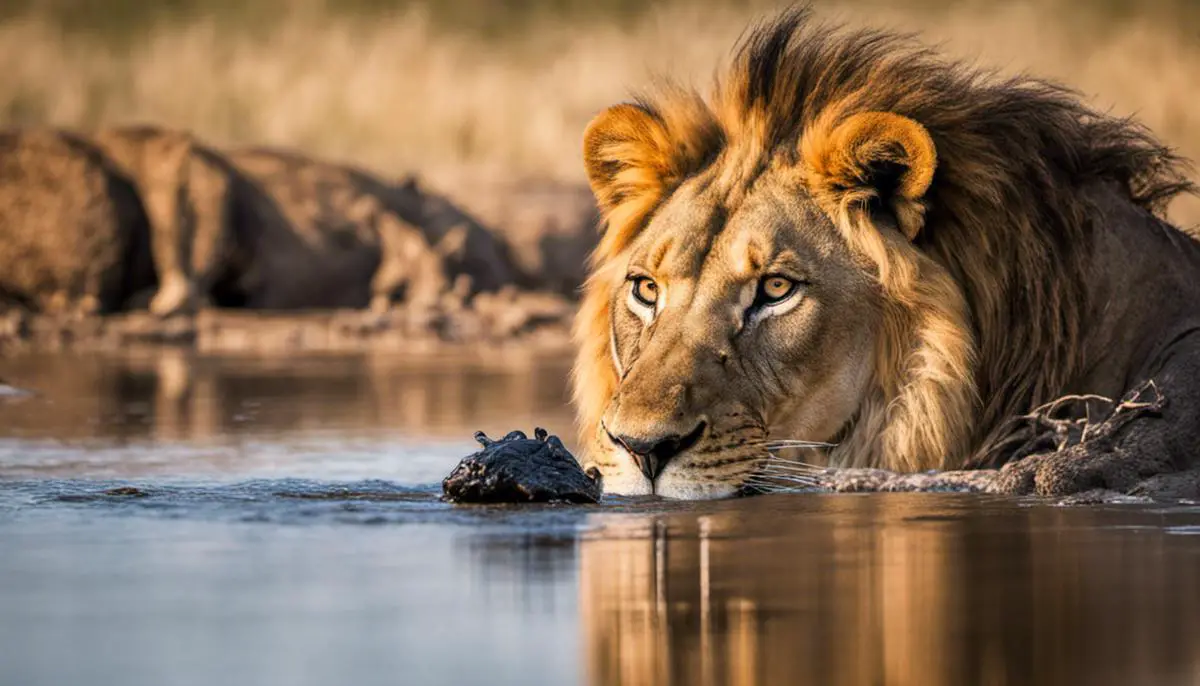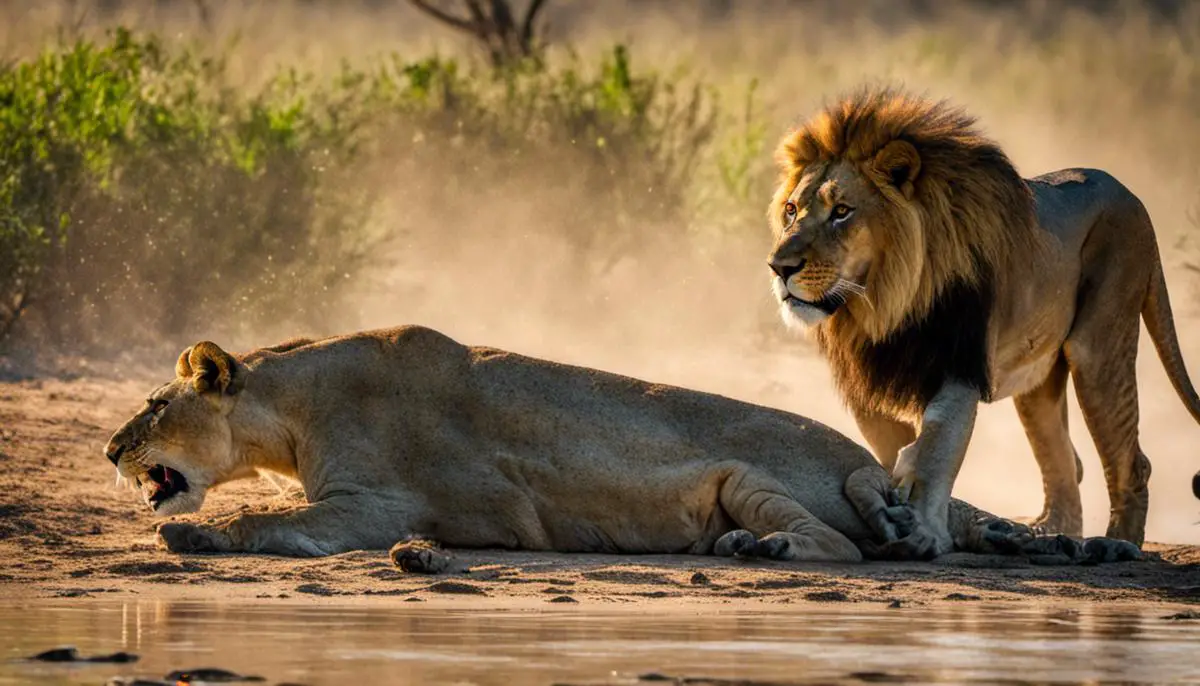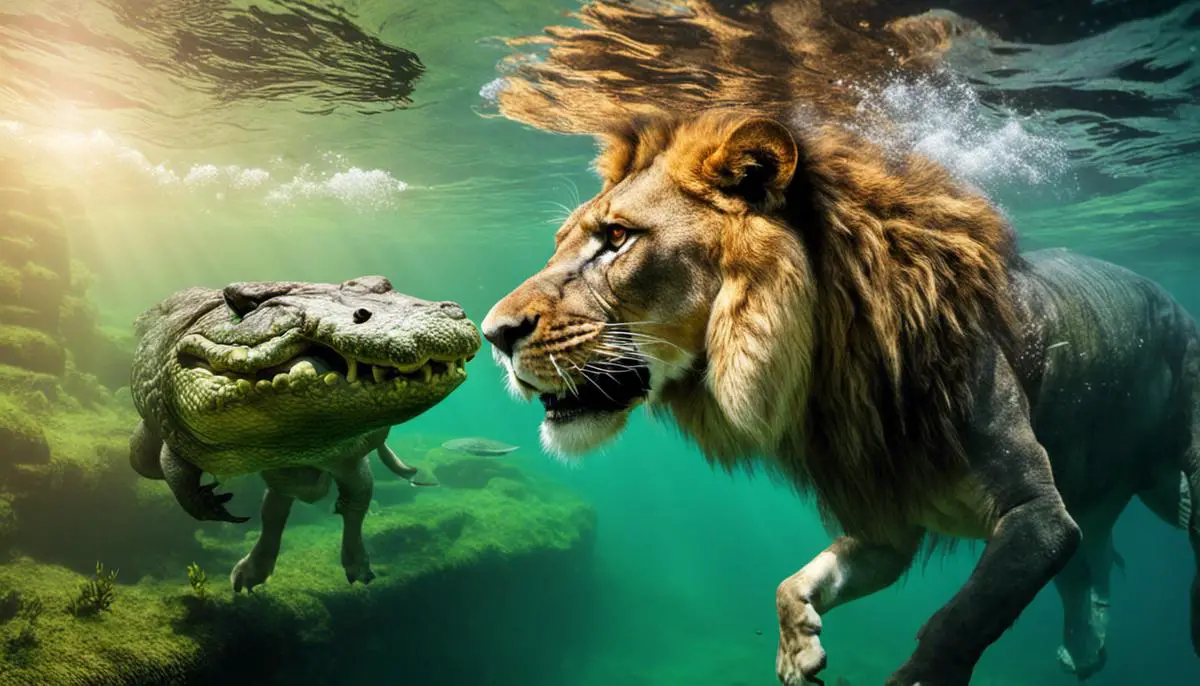Understanding Fear Factors: Lions versus Crocodiles
The animal kingdom, teeming with a plethora of species, brims with fascinating dynamics of power and fear, particularly amongst apex predators. One of the most intriguing interactions to behold is that between the lion, often dubbed ‘the king of the jungle’, and the crocodile, an equally formidable force in its aquatic domain.
This interplay not only provides a captivating study of nature’s raw, unadulterated power, but also fosters an understanding of the primitive emotion of fear, an emotion humans and animals share alike.
This exploration predominantly centres around the intersections in natural habitats, the inherent defensive and offensive behaviours, key attributes and physical abilities, as well as fear responses in both lions and crocodiles.
Interactions in Natural Habitats
Incidences and Dynamics of Lion-Crocodile Encounters in their Natural Habitats
For the uninformed reader, the delineation of lions’ territories seldom encompasses aquatic ecosystems, hence, their encounter with crocodiles may appear at best an anomalous spectacle of nature’s parlour. However, in the realm of ethology, persistent research has shed insightful epiphanies pertaining to the frequency and circumstances of lion-crocodile interactions in their shared landscapes.
Crocodilians and lions cohabit several ecosystems across the African continent, from the savannahs of the Serengeti to the intricate river systems of the Okavango Delta. Because lions require water daily and crocodiles inhabit aquatic areas, their encounters, although not frequent, are somewhat inevitable. One must not overlook the significant biological semantics associated with these encounters.
Crucially, the risk-fraught interactions between these two apex predators mainly occur around water bodies, typically during the dry season when water and food resources are scarcer, coaxing herbivores towards perilous crocodile-infested waters. Lions, relying on such congregations for sustenance, are drawn at the waterholes, thereby creating the stage for these encounters.
Scientific reports elucidate that lions engage with crocodiles mostly in two scenarios: either actively, during defence of their prides or kill, or passively, cautiously sharing the water resource in a display of ecological tolerance. Directly engaging a crocodile is a calculated risk taken by lions only as a deterrence strategy, placing their innate instinct of self-preservation at stake.
While the interactions between lions and crocodiles are by no means frequent, a comprehensive review in the Journal of East African Natural History highlights 20 instances over a duration of six years in the Serengeti National Park. Herein, lions were observed provoking crocodiles only six times, typically when the latter posed salient threats to lion prides or kills.
Further scientific literature points out that comparatively, the famed Marsh pride of Kenya’s Maasai Mara Reserve has experienced fewer encounters with crocodiles, attributed to the availability of numerous less-risky water sources. It is evident that varying ecological variables, including resource availability, predator density, and habitat complexity play auxiliary roles influencing these sporadic meetings.
Precisely, this delicate dance of survival between lions and crocodiles elucidates the intricate mechanisms of predator interaction and inter-species dynamics in the African ecosystem. It underscores not just the behavioural complexity and adaptability of these predators, but also their interdependence on ecological variables and shared resources.
Therefore, any definitive assertion pertaining to the frequency of lion-crocodile encounters is contingent upon a multitude of ecological factors, marking this subject an ever-evolving focal area in the expansive repertoire of wildlife science. This, indeed, forms a stimulating challenge for the researchers, a testament to the ever-unfolding enigma invariably associated with the study of ethology and behaviour.

Defensive and Offensive Behaviors
In thinking about the defensive and offensive tactics employed by lions and crocodiles, interactions between these two large predators reveal a fascinating portrayal of primal strength, cunning strategies and survival instincts, reflecting the complex, high-stakes nature of life in the wild.
This article seeks to elucidate the behavioural adaptation seen in these predators and thereby shed light on the interspecific interactions that characterise their shared ecosystems.
Lions, king of the savannah, are generally seen as apex predators, yet their strategic survival methods reflect an appreciation for the nuanced predator-prey dynamic in their habitat. When faced with the crocodile, a competitor and potential threat, lions have been observed to exercise prudence before attacking or venturing near water bodies. Lions undoubtedly possess physical prowess and agility on land.
However, acknowledging a crocodile’s dominance in aquatic environments, they meticulously assess the risk and reward involved in every encounter and adjust their response accordingly.
When considering the defensive behaviour of lions, it involves a combination of threat displays and avoidance strategies. Roaring, baring of teeth, swiping their large, pawed forearms, and combining these intimidating acts with strategic retreats, are common tactics employed by lions to deter potential crocodile attacks.
Conversely, the dominant offensive tactic of lions, when needed, is an organised group attack, commonly perpetrated by a pride’s mature females. The lionesses corner the crocodile, disrupting its movement, while delivering powerful bites and swipes intended to incapacitate it.
The crocodile, on the other hand, is an ambush predator that excels in aquatic environments. It capitalises on its natural camouflage and stealth to launch sudden attacks on unsuspecting lions.
Despite this, in the face of a formidable adversary like the lion, crocodiles display a distinct behavioural pattern. Non-aggressive posturing characterises their response, with wide-open jaws and hissing sounds serving as primary deterrents to encroaching lions.
Offensively, crocodiles exploit their water-based advantage, using the element of surprise combined with a powerful death roll – a manoeuvre where the crocodile forcefully rotates its body to subdue or disorient its prey.
Notably, crocodiles have been documented engaging lions primarily when they are directly threatened or when an opportunity presents itself – typically when a lion is vulnerable, such as drinking or swimming in the water.
These behavioural patterns underline an endemic adaptation to shared ecosystems, survival tactics and interspecific competition. They exhibit a dynamic relationship of power and vulnerability, shaped by ecological truths and evolutionary pressures brought on by their shared landscapes.
These exchanges between lions and crocodiles constitute a thrilling narrative of survival, unfolding on the unforgiving stage of the African wild, reminding us of nature’s ceaseless evolution and the intricate weave of life and death therein.

Anatomy and Physical Abilities
Diving deeper into the intricate array of behaviours and physical characteristics, one must commence by appreciating the lions’ formidable anatomical capabilities. Undeniably, the ‘King of Beasts’, as they are often referenced, harness their anatomical strengths to maintain their regal status in the African ecosystem. Notably, the powerful combination of robust forelimbs, excellent night vision, and speed during short bursts render lions as apex predators, utterly capable of challenging crocodiles.
Examining the lioness reveals a strategic savvy embedded within the pride’s social structure. Remarkably, they are often the ones meticulously planning and executing group attacks, showcasing superior coordination and cooperation in felling larger prey including crocodiles. Their anatomy aids in this shared predatory effort, displaying strength in unity.
Naturally, one might expect such an apex predator to solely employ offensive strategies, yet prudence prevails amongst lions, influenced by the formidable presence of crocodiles. Lions adopt a variety of avoidance strategies and threat displays that exemplify strategic analytical capabilities honed by eons of evolutionary necessity.
Contrastingly, crocodile anatomy reveals propensity for ambush tactics, consolidating them within Africa’s pantheon of apex predators. Residing below the water’s surface, tactically close to the edge, crocodiles employ an element of surprise, harnessing their powerful jaws and rapid propulsion to seize unsuspecting prey.
An intriguing aspect of crocodile hunting behaviour is the ‘death roll’. Predicated on the rotational strength and flexibility of their musculoskeletal structure, the crocodile will latch onto the prey and initiate a rapid, disorienting roll beneath the water.
Interestingly, crocodiles often adopt a more pacifistic posturing when confronted with a lion. This behavioural trait further exemplifies the evolutionary pressure exerted by the sheer physical prowess of lions, nudging crocodiles towards clever mitigation strategies.
Upon critical analysis, it is clear that lions and crocodiles have evolved unique adaptational capabilities that allow for survival and dominance in a shared ecosystem fraught with competitive pressures. Their dynamic relationship paints a marvellous picture of life in the African wild – a ballet of power, survival, and adaptation that is simultaneously brutal and beautiful.
Examining the intricacies of these interspecific interactions not only provides insight into the fascinating world of wildlife but also underscores the vital necessity for conservation efforts in preserving these complex ecosystems.
It offers an invaluable glimpse into the ultimate survival contest, propelling the lion and crocodile ever closer to the pinnacle of evolutionary triumph. Unquestionably, these formidable foes remain a source of ceaseless curiosity for wildlife scientists, a testament to the eternally mesmerising dance of the African wild.

Fear Responses in Animal Kingdom
Understanding the Constitution of Fear in Animals: Spotlight on Lions and Crocodiles
Fear, a primal sensation universally acknowledged yet inherently complex, transcends species boundaries, rendering it a crucial subject of study in behavioural ecology. Fear in animals is typically deduced from observable behaviours – a promising yet challenging field of study riddled with inherent individual and species variances. Thus arises the critical question: what constitutes fear in animals and how is it exhibited in such extraordinary predators as lions and crocodiles?
To begin unravelling this enigma, one may glance towards the existing body of literature on animal fear responses, primarily centred around the “fight or flight” principle. Fear may trigger either avoidance or aggression, depending on an animal’s assessment of a given threat. Therefore, analysing behavioural responses to perceived threats provides invaluable insights into the constitution of fear among animals.
Turning our gaze to lions – the quintessential ‘kings of the jungle’ – their fear responses are fascinatingly complex. When facing crocodiles, these apex predators exhibit a complex spectrum of behaviours.
Resistance to engage dolorously, conspicuous growls, deferential posture alterations, and revoking territorial claims signal the manifestation of fear. Moreover, threat perception influences pride dynamics, dictating when lionesses participate in group attacks, a strategy markedly enhancing their survival odds.
However, the fear phenomenon is not exclusive to lions. Crocodiles – regarded as one of Earth’s most successful surviving predator species – also shed light on fear manifestations amongst animals. Confronted by lions, crocodiles engage in calculated displays of non-aggression and elusiveness, the subtle intimations of a fear response. Indeed, despite being potent ambush predators, crocodiles appear to assert power through masterfully choreographed ‘shows’ of benignness, symbolising a fear-mediated shift from overt aggression.
Interestingly, the ‘death roll’ tactic, typically correlated with crocodile feeding behaviours, may also be construed as a fear response – a potent predator’s desperate struggle for survival. This finding underscores the multifaceted nature of fear responses, where even ostensibly aggressive behaviours may be underscored by inherent fear.
In the rich tapestry of shared ecosystems, this dynamic interplay of fear forms a pivotal component of interspecific competition. The evolving dance of survival steered by fear underscores its role as an evolutionary pressure, shaping animal behaviours, interactions, and subsequently, entire ecosystems. Fear, far from being a mere adverse sensation, thus emerges as a powerful determinant of ecological structure – a testament to its pivotal role in the grand scheme of life.
The fear responses exhibited by lions and crocodiles in shared ecosystems serve as intriguing case studies in the exploration of fear-based behavioural ecology. Conservation efforts must therefore account for this subtle interplay, preserving not just animal species, but the intricate dynamics that bind them and shape their shared ecosystems. Undoubtedly, the study of fear in animals, with its inherent complexities, promises exciting insights, paving the way for further breakthroughs in wildlife science.
Having delved into the intricacies underlying the interactions between lions and crocodiles, the attributes that influence their power dynamics and the concept of fear response, we are ushered into an amplified understanding of this complex relationship.
Fear, as it turns out, does not single out any species, regardless of its perceived dominance or strength. It finds its roots not just in the physical prowess or potential threat posed by an adversary, but also in the instinctual understanding of survival itself.
The study exemplifies the fact that it’s not the strongest that survive in the wild, perhaps, but those who recognise threat and exhibit the most adaptable behaviour, encapsulating the truth of Darwin’s claim, “It is not the strongest, but the most adaptable that survive.”
Thus, the fear of a lion for a crocodile or vice versa could be seen as less of an emotional reaction, and more of an evolved survival instinct, intrinsic to their behaviours, and a testament to the ruthless laws of nature.
